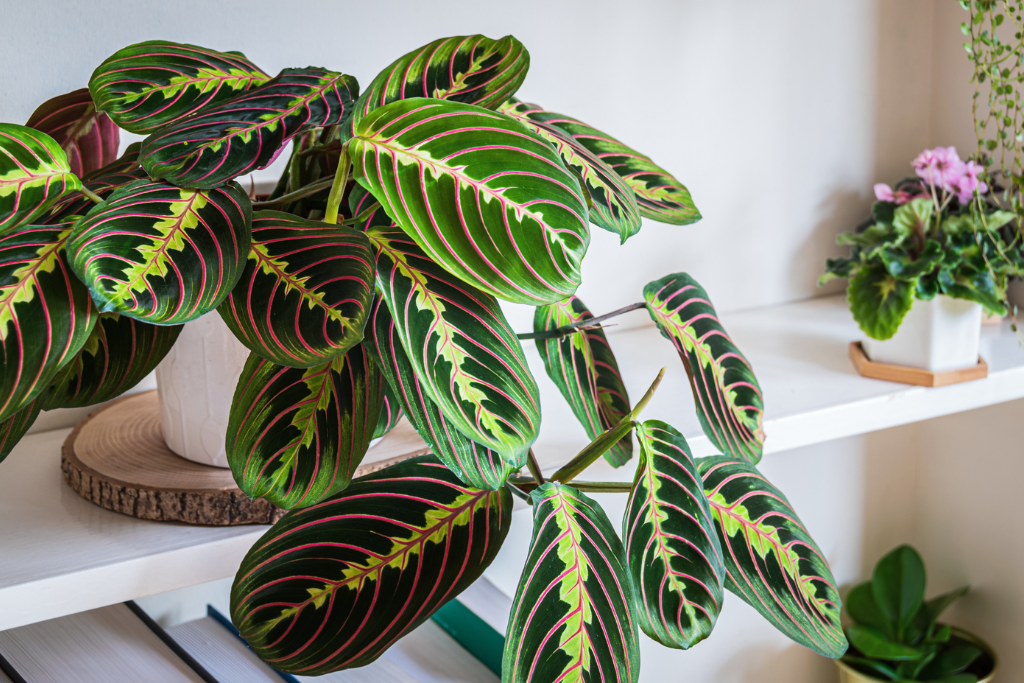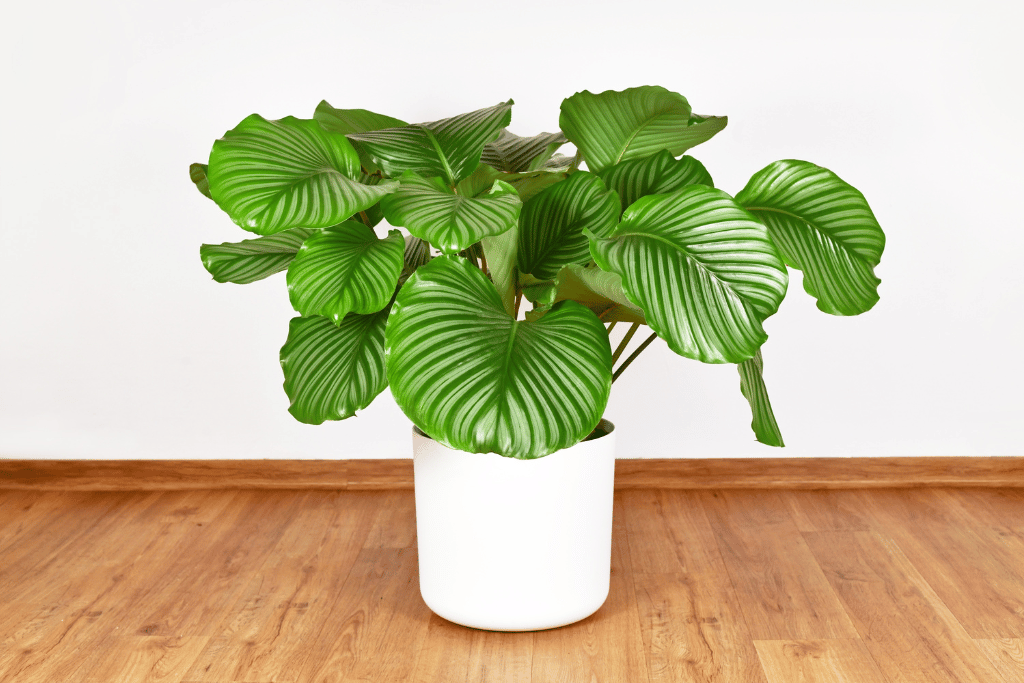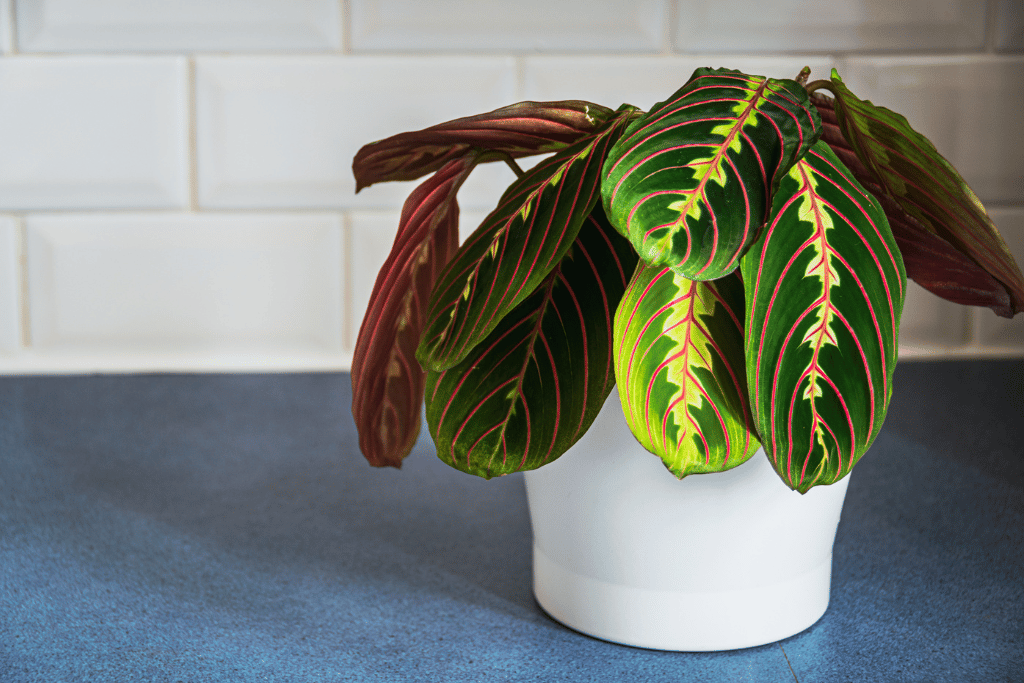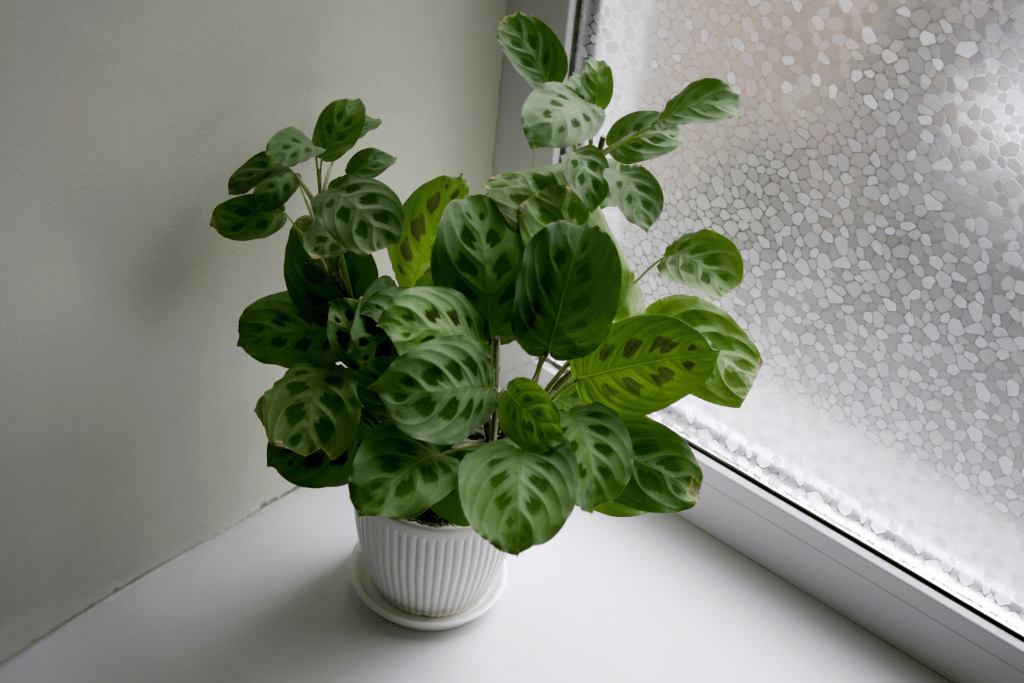
Does your house look dull and drab? Try sprucing it up with some prayer plants. They’re packed full of character, boast impressive patterns, and come in all shapes & sizes. But with so many different types of prayer plants around, it can be challenging to figure out which one is right for you. Let’s simplify it and help you choose the ideal prayer plant.
12 Types of Prayer Plants
Wondering how many types of prayer plants are there? Well, there are 50+ species. However, we’ll be discussing 15 types of prayer plants with pictures.
1. Calathea orbifolia:

This beautiful Calathea orbifolia has large, round leaves with a pleasing silver-green shade. It’s frequently preferred by plant lovers who want an eye-catching addition to their plant collection. Native to South America, this plant prefers warm and wet climates.
However, keep in mind not to overwater it as root rot is likely if the soil stays too wet. Besides, it requires bright indirect light and regular misting to keep the humidity levels at an ideal level. All in all, this is a great pick for green thumbs.
2. Calathea makoyana:

The Calathea makoyana is named after a Belgian horticulturist, Louis Benoit Van Houtte’s friend and colleague, René Makoy, who was also a botanist. It is a member of the Maranta family and is related to other popular houseplants like the prayer plant and the Calathea orbifolia.
The plant has beautiful foliage with dark green leaves that have intricate feather-like markings in silver, pink, and cream, to give the appearance of peacock feathers.
Lastly, it is a relatively low-maintenance plant that prefers bright but indirect light and moist soil. Moreover, it is also sensitive to chlorine and fluoride, so it’s recommended to water it with distilled or filtered water.
3. Maranta kerchoveana:

People often ask: what types of plants to use in prayer garden? Well, Maranta kerchoveana can be one of the many.
The Maranta kerchoveana is a species of prayer plant that features eye-catching foliage with unique variations in color, shape, and size. It can enhance the aesthetics of both indoor and outdoor spaces. To ensure that the plant remains healthy and thrives, it is important to adhere to a few basic care instructions.
Placing the Maranta kerchoveana in an area with good indirect sunlight. It loves bright, but not direct light, so it’s best suited near a window that receives morning or late afternoon sun.
Watering your plant according to its needs. It should never be soggy or dry; aim to keep the soil moist but not saturated. If you’re unsure of how much water it needs, stick a finger into the top inch of soil and if it’s dry give it some water.
Give your Maranta kerchoveana some fertilizer once a month during spring and summer when the plant is actively growing. During autumn and winter it can be put on hold as the plant tends to slow down its growth cycle in these seasons.
4. Maranta tricolor prayer plant:

The Maranta tricolor Prayer Plant is a houseplant that stands out. Not only do its leaves come in various shapes and colors, but it also has an interesting way of reacting to its environment- when light begins to fade, it responds by folding up its leaves like praying hands.
This unusual characteristic makes it an excellent conversation starter for your home. If you want to transform your abode with beauty, the Maranta tricolor prayer plant is an excellent choice to go with! Speaking of its appearance, it’s a sight to behold – with its tricolor leaves and vibrant hues.
Despite its delicate appearance, it’s quite easy to care for – just make sure you keep it watered, and give it some fertilizer from time to time. In short, it’s a low-maintenance addition to your home that will add an exciting, unexpected flair.
5. Maranta leuconeura kerchoviana:

The Maranta leuconeura kerchoviana is not only a beautiful plant but also helps to purify the air in your home by removing toxins such as formaldehyde and benzene. Interestingly, the Maranta leuconeura kerchoviana is one of the few plants that can grow and thrive under fluorescent lighting, making it an excellent choice as plants for offices and other indoor spaces with limited natural light.
The plant goes by another name – the “Rabbit’s Foot” prayer plant. It is native to Brazil’s rainforests and popular among houseplant fans due to its furry brown spots like a rabbit’s foot, as well as its light green foliage with dark green veins. This species of the Maranta family is a real eye-catcher. It’s easy to see why it’s so beloved.
The Maranta leuconeura kerchoviana has a variety of traditional medicinal uses in Brazil, where it is often used to treat skin irritations and gastrointestinal issues.
6. Calathea medallion:

This South American beauty is native to Brazilian rainforests and a member of the Marantaceae family, which consists of up to 300 diverse species. The leaves of Calathea medallion are large and oval-shaped with a dark green hue on top and lighter stripes with a deep purple underside.
An interesting trait of this plant is its ‘nyctinasty’, that is, its movement in response to changes in light and temperature. It also serves as an air purifier and it is safe for use around pets or children.
Lastly, it’s quite low maintenance; requiring only indirect sunlight and consistent moisture but not waterlogged soil. Furthermore, this plant prefers warm, humid environments. Lovely and practical.
7. Maranta lemon lime prayer plant:

This Maranta lemon lime prayer plant is great for injecting a splash of color into your home. Its lush green leaves feature delicate pink undertones, making it visually pleasing and lovely to behold. To keep the foliage in tip-top condition, provide indirect lighting and high humidity. Get creative with interior design and introduce this stunning prayer plant into your home today.
8. Calathea lancifolia:

This 30-inch tall, 18-inch wide perennial is perfect for newbies. Its lance-shaped leaves boast a green main color with darker stripes along the middle. The underside of the leaf? A delightful deep purple. Rarely seen when grown inside, it does produce white or purple flowers on lengthy stalks.
Bright, indirect light is best for this plant, but it can tolerate dimmer conditions so long as you avoid direct sunlight that could burn the leaves.
Furthermore, ensure well-draining soil and consistent moisture without overdoing it. As for humidity, it should be kept high with occasional misting.
9. Calathea roseopicta:

The Calathea roseopicta is a gorgeous houseplant with vibrant pink and green striped leaves. It’s very suitable for many living conditions, as long as you look after it properly. This plant may bring joy to your residence for a lengthy period if cared for adequately.
10. Calathea musaica:

Native to Brazil, the Calathea musaica is an eye-catching prayer plant with foliage featuring a unique mosaic pattern. This plant needs bright indirect light and lots of humidity in order to stay healthy. Overwatering is not recommended as it can cause root rot.
An ideal pick for those looking to add a dramatic touch to their indoor plant collection, the Calathea musaica is bound to be a showstopper.
11. Calathea beauty star:

The Marantaceae family member Calathea beauty star is a tropical beauty. Its leaves boast an array of shades – green, pink, silver or even purple, and intricate patterns that add to its allure.
This easy-to-care-for plant will thrive in moderate to low light conditions which makes it perfect both for indoor and outdoor spaces. To keep it healthy, make sure the top inch of soil is dry before watering. It is best suited for well-draining, nutrient-rich soil. Keep it moist but not waterlogged. That’s all you need to know to get a head start with the Calathea beauty star.
12. Maranta green prayer plant:

The Maranta green prayer plant is a classic prayer plant with deep green leaves that feature subtle patterns in shades of light green and silver. This plant hails from South America and loves the sun, but not too much of it! It requires bright, indirect lighting to stay happy and healthy. In terms of humidity, keep this plant’s environment nice and moist – but don’t make it overly wet or else risk root rot.
Frequently Asked Questions (FAQ)
What types of prayer plants are there?
There are several types of prayer plants (Maranta species) that are popular for their unique foliage patterns and ease of care. Some of the most common types of prayer plants include:
1 – Maranta leuconeura (also known as the red prayer plant)
2– Maranta leuconeura var. kerchoveana (also known as the rabbit’s foot prayer plant)
3 – Maranta leuconeura var. erythroneura (also known as the herringbone plant)
4 – Maranta arundinacea (also known as the arrowroot plant)
What types of plants to use in an eagle scout project prayer garden?
You can use:
1 – Lavender: Known for its soothing scent, lavender is a popular choice for prayer gardens.
2 – Rosemary: With its fragrant leaves and pretty blue flowers, rosemary is a great choice for a prayer garden.
3 – Sage: Another herb with a soothing scent, sage is often used in spiritual rituals.
4 – Chamomile: This fragrant herb is said to promote relaxation and calmness.
5 – Angelonia: A low-maintenance flowering plant that comes in a variety of colors.
6 – Coreopsis: A hardy flowering plant that attracts butterflies and bees.
7 – Echinacea: Also known as coneflower, this plant has pretty pink or purple flowers that are said to symbolize spirituality and inner strength.
How often should I water my prayer plant?
Drowning your prayer plant isn’t a good idea. So, hold off on watering until the top inch of soil is dry. Generally speaking, once a week should suffice – but if you feel the need to adjust that frequency, then go for it! Show some love to your lovely leafy friend.
How can I create a peaceful atmosphere in my prayer garden?
If you’re looking for a tranquil area to pray and reflect, you need to make sure your prayer garden is set up just right. Create a peaceful atmosphere by adding elements like calming water features, wind chimes and comfy seating. You can go with plants like lavender and chamomile as well.



